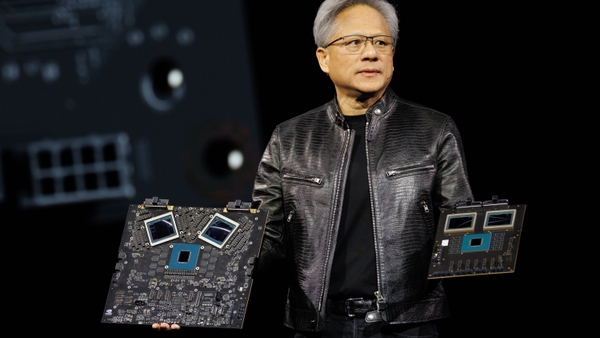Data Center Revenue Explosion Solidifies NASDAQ:AMD's Position in AI
NASDAQ:AMD has achieved an extraordinary milestone with its data center segment, delivering a stunning 122% year-over-year (YoY) growth to reach $3.5 billion in Q3 2024. This performance highlights AMD’s strategic pivot toward high-margin, AI-driven opportunities. Data center now represents 52% of total revenue, emphasizing AMD’s shift from traditional CPU reliance to becoming a critical player in the AI acceleration market.
This transformation stems from AMD’s continued dominance with its EPYC processors, deployed at scale by industry titans such as Meta Platforms (NASDAQ:META) and Microsoft (NASDAQ:MSFT). Meta alone has integrated 1.5 million EPYC CPUs across its global data center fleet to support their AI models, including Llama 3.1, a next-generation frontier AI tool. AMD’s role as a trusted infrastructure provider for such pivotal AI workloads confirms its competitive strength against long-standing leader Nvidia (NASDAQ:NVDA).
Beyond CPUs, AMD’s Instinct MI300X accelerators have become a critical AI solution. With significant adoption by Microsoft for its Copilot services and Oracle’s deployment of MI300X across its OCI Compute Supercluster, AMD’s GPU solutions are making substantial inroads. Early customer feedback indicates a 30% performance advantage over competing products, further validating AMD’s ability to challenge Nvidia in this high-stakes market.

Accelerated AI Momentum and Future Growth Prospects
AMD’s confidence in the AI space is reflected in its upwardly revised projections. Initially forecasting $2 billion in AI revenue for 2024, AMD has since raised this to exceed $5 billion, a testament to surging demand and rapid customer adoption. The company anticipates the total addressable market (TAM) for AI accelerators to expand at a 60% annual growth rate, reaching $500 billion by 2028. AMD’s aggressive product roadmap, including the upcoming MI325X accelerator and future MI400 series (based on the CDNA Next architecture), underscores its commitment to capturing this massive growth opportunity.
In Q4 2024, the MI325X will hit the market, boasting up to 40% higher inference performance compared to Nvidia’s H200. System availability through partners such as Dell, Hewlett Packard Enterprise (HPE), Lenovo, and Super Micro is expected by Q1 2025, ensuring AMD a solid foothold in AI infrastructure deployment.
Record Profitability Highlights Operational Excellence
AMD’s robust Q3 results showcased 18% YoY revenue growth, reaching $6.8 billion, while gross margins expanded to 54% (Non-GAAP), up from 51% in the prior year. Operating income increased 34% YoY, reflecting exceptional operational efficiency. AMD's focus on high-margin segments, particularly data centers, is clearly paying off.
Cash flow generation remained strong, with operating cash flow at $628 million, a 49% increase YoY. This financial stability ensures AMD can continue its aggressive R&D investments while maintaining a conservative debt-to-equity ratio of 3.93%.
Management’s Q4 guidance of $7.5 billion in revenue (representing 22% YoY growth) further solidifies AMD’s momentum heading into 2025. Coupled with stable gross margins and strategic inventory buildup to support data center expansions, AMD appears well-prepared to sustain its growth trajectory.
Key Partnerships and Product Diversification
AMD’s growth is not confined to AI and data centers. The client computing segment has rebounded, with 29% YoY growth in Q3, driven by strong demand for its Zen 5 processors. Notably, AMD is capitalizing on the upcoming Windows 10 end-of-support cycle in 2025, targeting enterprise PC upgrades with its Ryzen AI Pro processors. These processors, with 50+ NPU TOPS for AI workloads, position AMD to dominate the emerging AI-PC market.
Major OEMs such as HP and Lenovo are on track to triple their Ryzen AI platform offerings in 2024, reflecting strong ecosystem support for AMD’s vision.
In the gaming segment, however, revenue declined 69% YoY, reflecting broader market challenges. Nevertheless, AMD’s focus on high-growth areas mitigates these headwinds.
Competitive Risks and Strategic Responses
Competition remains a significant challenge for AMD, particularly from Nvidia’s entrenched leadership in AI accelerators and Intel’s renewed focus on reclaiming data center market share. Additionally, hyperscalers like Amazon and OpenAI’s reported development of custom silicon could disrupt AMD’s TAM in the AI space.
To counter these risks, AMD continues to invest heavily in innovation and partnerships. For instance, its ROCm software stack has narrowed the gap with Nvidia’s CUDA, achieving a 2.4x improvement in inferencing performance. AMD’s comprehensive product roadmap and expanding ecosystem partnerships position it to weather these competitive pressures effectively.
Valuation Reflects Opportunity
Despite its premium valuation, with a forward P/E of 42.7x, AMD remains attractively priced relative to growth prospects. Its PEG ratio of 1.01x (versus a sector median of 1.9x) underscores its undervaluation when factoring in its projected 42.2% EPS growth rate. By comparison, Nvidia’s forward P/E of 46.93x highlights AMD’s relative affordability despite comparable growth potential.
The recent pullback presents a compelling entry point for investors. Technical indicators, including a bullish flag pattern, suggest AMD is poised for a breakout, with potential upside targets of $200 in the coming quarters.
Strategic Investments Secure Long-Term Growth
AMD’s balance sheet, with $4.5 billion in cash and a net debt position of -$2.3 billion, provides ample flexibility for strategic initiatives. Recent investments in R&D and capacity expansion reflect AMD’s commitment to sustaining its competitive edge.
Moreover, AMD’s supply chain improvements, reflected in Q3 inventory levels increasing to $5.37 billion, ensure it is well-positioned to meet surging demand in the data center market.
Decision on NASDAQ:AMD – Buy, Sell, or Hold?
Given its exceptional growth in data centers and AI accelerators, strong financial metrics, and robust product pipeline, NASDAQ:AMD is a strong buy. The current pullback offers a rare opportunity to invest in a company at the forefront of AI and computing innovation. While competition from Nvidia and Intel poses risks, AMD’s strategic initiatives and growing customer adoption mitigate these challenges, supporting a bullish outlook into 2025.
AMD’s ability to consistently deliver above-market growth and expand into lucrative markets such as AI, cloud computing, and enterprise PCs makes it an attractive long-term investment for those seeking exposure to the transformative potential of semiconductor technology.

















